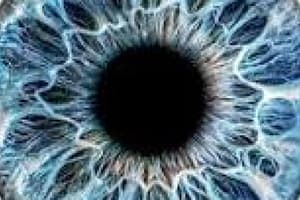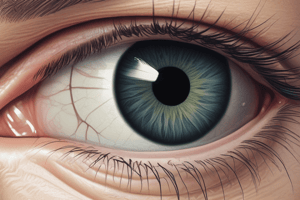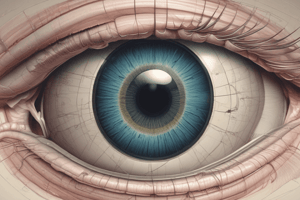Podcast
Questions and Answers
What is the recommended method for managing splash injuries to the eye?
What is the recommended method for managing splash injuries to the eye?
- Use cold compresses to reduce swelling
- Apply an antibiotic ointment immediately
- Irrigate with normal saline solution (correct)
- Cover the eye with a bandage
Which precaution should be taken when handling potentially dangerous items like scissors?
Which precaution should be taken when handling potentially dangerous items like scissors?
- Only supervise children with dull scissors
- Encourage children to show their friends how to use scissors
- Teach children the correct way to handle them (correct)
- Allow children to use them without supervision
When using jumper cables, which safety precaution is NOT recommended?
When using jumper cables, which safety precaution is NOT recommended?
- Never lean over the battery when attaching cables
- Ensure the cars are not touching each other
- Make sure the jumper cable clamps never touch each other
- Attach a cable to the negative terminal of a dead battery (correct)
Which condition is most commonly associated with an increased risk of cataracts?
Which condition is most commonly associated with an increased risk of cataracts?
What is the primary treatment option for cataracts once they significantly impair vision?
What is the primary treatment option for cataracts once they significantly impair vision?
What should be done if a foreign body is removed from the eye surface?
What should be done if a foreign body is removed from the eye surface?
Which of the following accurately describes a key nursing care consideration for patients with eye injuries?
Which of the following accurately describes a key nursing care consideration for patients with eye injuries?
Which group is most commonly affected by ocular trauma leading to blindness?
Which group is most commonly affected by ocular trauma leading to blindness?
What should be emphasized in patient education for individuals at risk for developing cataracts?
What should be emphasized in patient education for individuals at risk for developing cataracts?
In what case should cycloplegic agents be avoided after a ruptured globe?
In what case should cycloplegic agents be avoided after a ruptured globe?
What is a suggested action around fireworks for ensuring safety?
What is a suggested action around fireworks for ensuring safety?
Which factor is NOT associated with cataract formation?
Which factor is NOT associated with cataract formation?
Which type of cataract primarily affects the center of the lens?
Which type of cataract primarily affects the center of the lens?
Which of these is NOT advised when operating a lawn mower?
Which of these is NOT advised when operating a lawn mower?
Which of the following conditions can lead to damage related to macular degeneration?
Which of the following conditions can lead to damage related to macular degeneration?
What dietary consideration is important for reducing the risk of cataracts?
What dietary consideration is important for reducing the risk of cataracts?
Which type of glaucoma is characterized by normal anterior chamber angles but optic nerve damage?
Which type of glaucoma is characterized by normal anterior chamber angles but optic nerve damage?
What is a common symptom of Acute Angle-Closure Glaucoma?
What is a common symptom of Acute Angle-Closure Glaucoma?
Which factor does NOT increase the risk of developing glaucoma?
Which factor does NOT increase the risk of developing glaucoma?
What is the primary treatment for managing elevated intraocular pressure in glaucoma patients?
What is the primary treatment for managing elevated intraocular pressure in glaucoma patients?
Which of the following is a symptom of Chronic Open-Angle Glaucoma?
Which of the following is a symptom of Chronic Open-Angle Glaucoma?
Which condition is NOT a precipitating factor for the progression of glaucoma?
Which condition is NOT a precipitating factor for the progression of glaucoma?
In assessing the presence of glaucoma, which test result indicates a potential diagnosis?
In assessing the presence of glaucoma, which test result indicates a potential diagnosis?
Which demographic is at increased risk for developing glaucoma?
Which demographic is at increased risk for developing glaucoma?
Flashcards
Glaucoma
Glaucoma
A group of eye conditions causing optic nerve damage and high eye pressure (IOP).
Open-Angle Glaucoma
Open-Angle Glaucoma
A common type where the drainage angle in the eye is open, but fluid outflow is impaired, gradually raising pressure.
Angle-Closure Glaucoma
Angle-Closure Glaucoma
A type where the drainage angle in the eye closes, blocking fluid outflow, causing a sudden pressure surge.
Increased Intraocular Pressure (IOP)
Increased Intraocular Pressure (IOP)
Signup and view all the flashcards
Risk Factors for Glaucoma
Risk Factors for Glaucoma
Signup and view all the flashcards
Progression of Glaucoma
Progression of Glaucoma
Signup and view all the flashcards
Acute Angle-Closure Glaucoma (AACG)
Acute Angle-Closure Glaucoma (AACG)
Signup and view all the flashcards
Chronic Open-Angle Glaucoma (COAG)
Chronic Open-Angle Glaucoma (COAG)
Signup and view all the flashcards
Child safety with toys
Child safety with toys
Signup and view all the flashcards
Lawn mower safety
Lawn mower safety
Signup and view all the flashcards
Car repair safety
Car repair safety
Signup and view all the flashcards
Sports safety eyewear
Sports safety eyewear
Signup and view all the flashcards
Firework safety
Firework safety
Signup and view all the flashcards
Ocular trauma
Ocular trauma
Signup and view all the flashcards
Splash injury treatment
Splash injury treatment
Signup and view all the flashcards
Foreign body removal
Foreign body removal
Signup and view all the flashcards
Cataract Risk Factors
Cataract Risk Factors
Signup and view all the flashcards
Cataract Pathophysiology
Cataract Pathophysiology
Signup and view all the flashcards
Age-Related Cataracts
Age-Related Cataracts
Signup and view all the flashcards
Glaucoma Medication Use
Glaucoma Medication Use
Signup and view all the flashcards
Cataract Formation
Cataract Formation
Signup and view all the flashcards
Follow-up Appointments
Follow-up Appointments
Signup and view all the flashcards
Eye Drop Administration
Eye Drop Administration
Signup and view all the flashcards
Ophthalmologist Report
Ophthalmologist Report
Signup and view all the flashcards
Study Notes
Anatomy of the External Eye
- Structures include the inner canthus, lacrimal sac, brow, upper lid, caruncle, naso-lacrimal duct, lower lacrimal canal, near lower lacrimal punctum, pupil, lacrimal gland, sclera, outer canthus, and limbus.
- The conjunctiva is also part of the external eye structure.
- Lacrimal structures are mentioned.
Anatomy-EOM and Eye Movement
- Extraocular muscles (EOMs) control eye movement.
- Specific muscles listed include superior oblique, superior rectus, lateral rectus, inferior rectus, and inferior oblique.
Anatomy of the Internal Eye
- Structures include the retina, choroid, vitreous body, sclera, retinal artery, retinal vein, central retinal artery and vein, macular area, zonules, canal of Schlemm, posterior chamber, anterior chamber, cornea, pupil, lens, and iris muscle, ciliary body.
Accommodation
- Accommodation is the ability to focus and refocus.
Gerontologic Considerations-Age related changes
- Age-related changes affect the eye, including dry eye, changes in eyelids and lacrimal structures, refractive changes, cataracts, and age-related macular degeneration.
Eye Assessment: History and Physical
- History, common complaints, past history, family history, social history, and physical assessment are part of the eye assessment process.
- Visual acuity, tested by Snellen chart. 20/20 considered normal.
- Examination of the external eye is performed.
- Additional tests include direct ophthalmoscopy, Amsler grid, tonometry, perimetry testing, slit-lamp exam, color vision testing, and ultrasonography. Fluorescein angiography is also mentioned.
Goal of Eye Assessment
- Preserving eye function for as long as possible.
Nursing Management: Patients with Eye and Vision Disorders
- Goal includes emotional, physical, and social adaptation, as well as providing appropriate resources.
- Types of vision loss include impaired vision and total vision loss or partial vision loss.
Refractive Errors
- Refractive errors occur when the eye shape prevents light rays from focusing sharply on the retina.
- Low vision describes a reduced ability to see that requires patients to use devices and strategies in addition to corrective lenses.
- Blindness involves various degrees of vision, such as BCVA (best corrected visual acuity) - 2400 or lower, and Absolute blindness or Legal blindness (BCVA - 2200 or lower).
Clinical Manifestations & Assessment of Low Vision
- Comprehensive history and physical examination, including activities affected, are crucial.
- Aids like canes, eyeglasses, and magnifying glasses may support daily activities.
- Web access for visually impaired, using assistive software.
Medical Management
- Includes medication for visual impairment, surgical procedures to address issues within the eye, and software for visual impairment.
Glaucoma
- Glaucoma involves optic nerve damage and increased intraocular pressure.
- Open-angle glaucoma is a type of glaucoma.
- Angle-closure (pupil block) glaucoma involves a blockage in aqueous humor outflow.
- Acute angle-closure glaucoma (AACG) is a condition with rapid progression of impaired vision, pain, and inflammation.
Risk Factors for Glaucoma
- Risk factors include family history of glaucoma, race (African, Caribbean, Hispanic), older age (over 60), diabetes mellitus, cardiovascular disease, migraine syndromes, nearsightedness (myopia), eye trauma, and prolonged use of topical or systemic corticosteroids.
Progression of Glaucoma
- Precipitating factors, such as illnesses, stress, and corticosteroids, are mentioned.
- Structural and functional changes in the eye are described. Optic nerve damage is a result.
- Different types of glaucoma are mentioned.
Glaucoma Medical and Nursing Management
- Treatments include topical/oral agents, beta blocker eye drops, and laser surgery.
- Detailed patient education on medication adherence and self-care is important.
Cataract
- Cataract is a clouding or opacity in the lens.
- Risk factors include age, conditions like diabetes mellitus, and exposure to toxic substances.
- Aging, breakdown of lens proteins, and decreased oxygen uptake are factors in forming cataracts. Other Risk factors include: corticosteroids, alkaline chemicals, smoking, poor nutrition, obesity, and conditions like retinitis pigmentosa, myopia, and retinal detachments.
- Associated ocular conditions, toxic factors, nutritional factors, and physical factors play a role. Systemic diseases like diabetes, and Down syndrome contribute to the condition.
Medical and Surgical Management of Cataracts
- Includes medication and surgical procedures such as intracapsular cataract extraction, extracapsular cataract extraction, phacoemulsification, and lens replacement.
Nursing Management of Cataracts
- Instructions for preoperative and postoperative care are included to prevent eye injuries and manage the side-effects of treatment.
Retinal Detachment
- Retinal detachment is caused by fluid accumulation between retinal layers.
- Rhegmatogenous detachment is the most common type.
- Manifestations include seeing floaters, flashing lights, or a curtain obscuring vision.
Macular Degeneration
- Macular degeneration leads to vision loss. Two types exist (wet and dry).
- Age-related macular degeneration is a progressive condition, typically affecting the central part of the retina.
Orbital Trauma
- Orbital trauma is a cause of blindness, a common event, especially among young adults.
- Health promotion to prevent eye injury is part of the discussion. The discussion includes specific instructions for use of products and tools in different settings (like the house, workshop, or garden).
Conjunctivitis
- Conjunctivitis is a common eye condition.
- Various types of conjunctivitis include microbial (bacterial, viral, allergic, and toxic), and their clinical manifestations and assessments.
- Conjunctivitis treatment and management are covered.
Orbital Cellulitis
- Orbital cellulitis is inflammation of the tissues surrounding the eye.
- The treatment and management of orbital cellulitis using immediate antibiotics is emphasized.
Pediatric Eye Conditions
- Conditions such as congenital cataracts, developmental issues like strabismus, are covered, explaining their etiology and clinical manifestations for specific therapy.
Studying That Suits You
Use AI to generate personalized quizzes and flashcards to suit your learning preferences.
Related Documents
Description
Explore the intricate structures of the eye, including the external and internal anatomy, extraocular muscles, and the process of accommodation. This quiz also covers age-related changes affecting the eye. Test your knowledge on these essential components of ocular anatomy and function.




